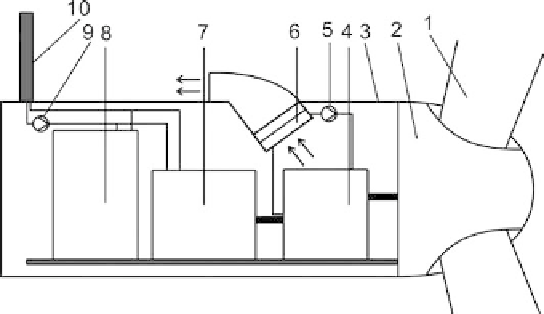Environmental Engineering Reference
In-Depth Information
winding, absorbing the heat produced by the generator. Finally, it will be pumped
out and get cooled by an external radiator, by which the fl ow is prepared for the
next cycle of heat exchange. In normal working condition, the cooling water pump
always stays in working mode to deliver the internal heat to the external radiator
through cooling medium. And the lubricating oil pump can be controlled by the
temperature sensor in the gearbox. When the oil temperature exceeds the rated
value, the pump switches on, delivering the oil to the oil cooler outside the gear-
box; while the oil temperature falls below the rated value, the circuit is cut off to
stop the cooling system. Besides, as the control converter in each wind generating
set varies to each other, there will be difference in the amount of heat produced
among these converters. When the heat production is relatively low, the forced air
cooling generated by the fan fi xed in the nacelle is suffi cient for the control con-
verter and other heat producing components; while if the heat production is com-
paratively large, a radiator outside the control converter can be installed to control
its temperature rise through cooling medium taking away the heat in the same way
of gearbox and generator.
With respect to the MW wind turbine with a larger power capacity, the gearbox,
generator and control converter all produce comparatively large amount of heat.
As shown in Fig. 5, cooling these components mentioned above usually needs two
independent sets of cooling system - one shared by the generator and control con-
verter and the other for the gearbox [14]. In an oil cooling system, the lubricating
oil is pumped up to lubricate the gearbox; the heated oil is then to be delivered to
the oil cooler on top of the central nacelle to be cooled by forced air. The cooled
lubricating oil is then delivered back to the gearbox for use of the next cycle. A
liquid cooling system is a closed-loop system containing an ethylene glycol aque-
ous solution-air heat exchanger, a water pump, valves, and control devices for tem-
perature, pressure and fl ux. The cooling medium in the closed-loop system fl ows
through the generator and the control converter to take away their produced heat.
Figure 5: A cooling system for one MW wind turbine [14]: 1, blade; 2, hub;
3, nacelle; 4, gearbox; 5 and 9, hydraulic pump; 6, oil cooler; 7, generator;
8, converter; 10, heat exchanger.

Search WWH ::

Custom Search